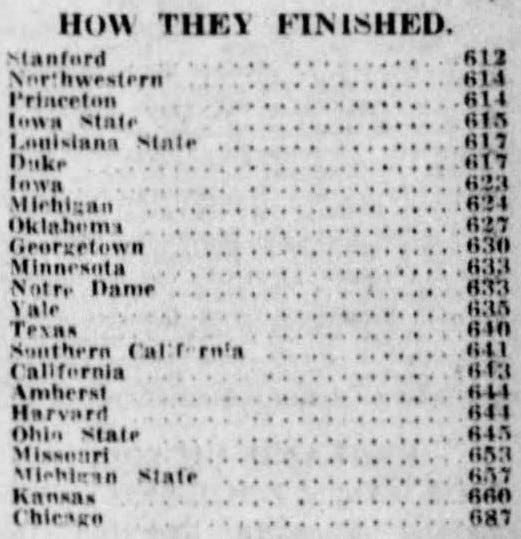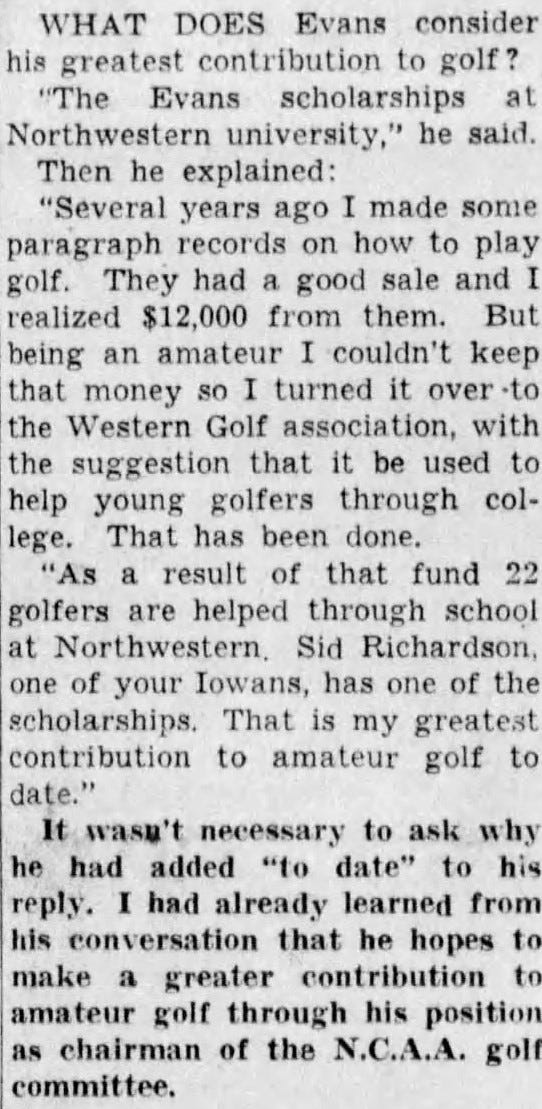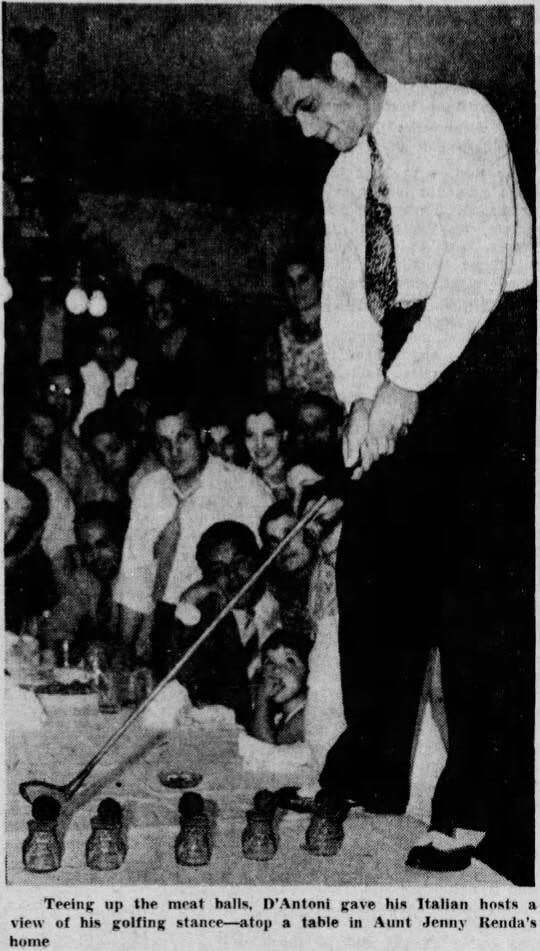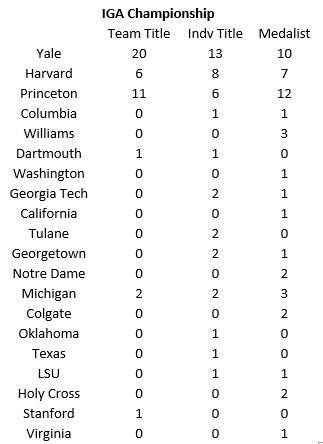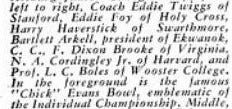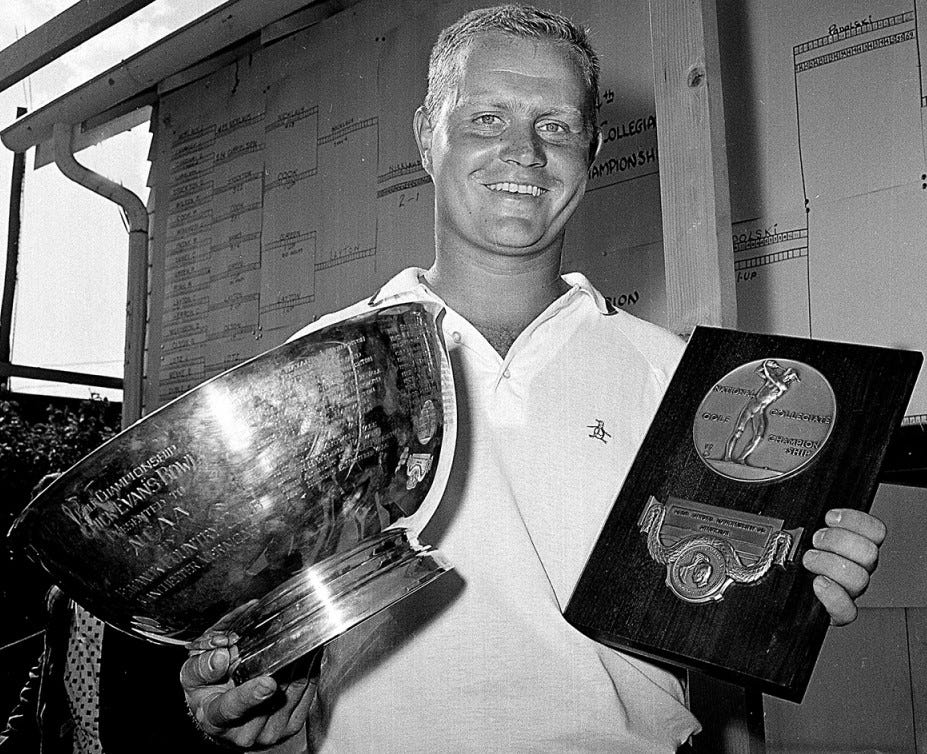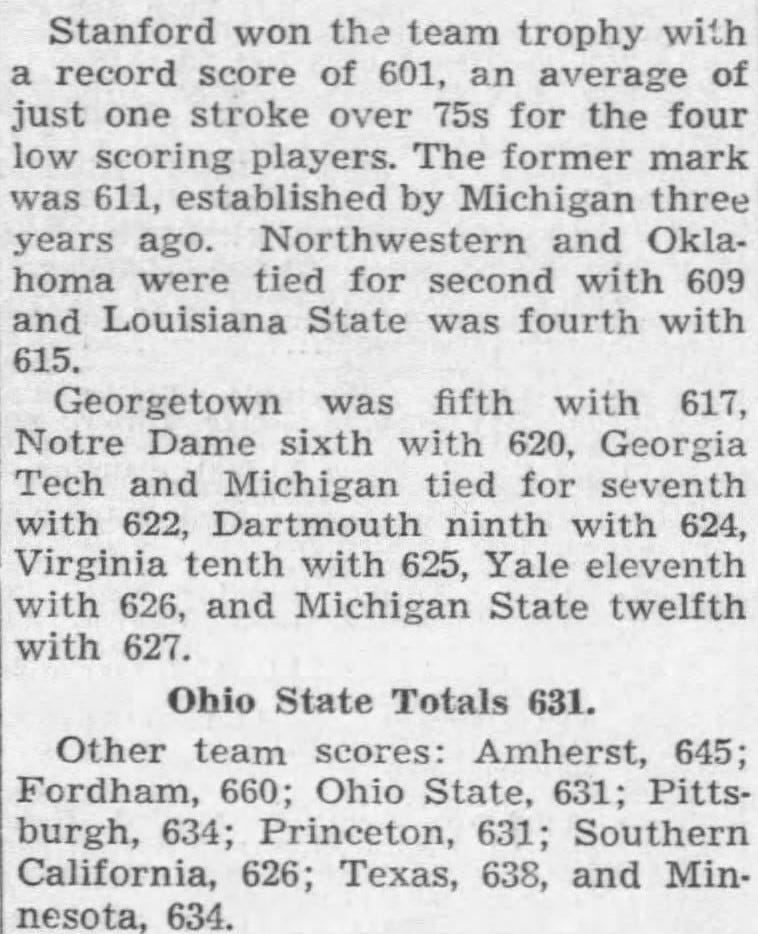This is part of a series on the Men’s Collegiate Championships
NCAA Championship Era: 1939-NOW
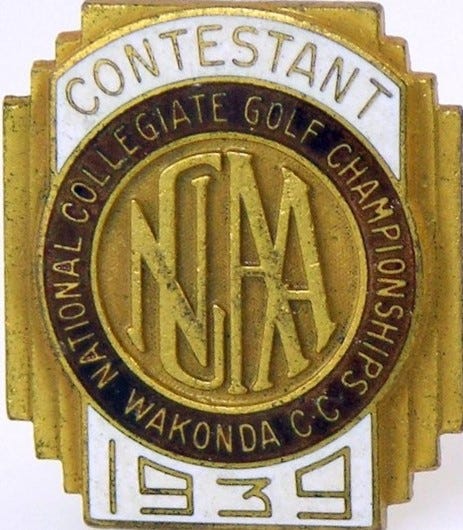
The National Collegiate Athletic Association (NCAA) was founded in 1906 but started hosting championships in the early 1920s. Consideration for the NCAA conducting a golf championship goes back as far as 1935 when Dean Frank Nicholson [Wesleyan, NCAA secretary-treasurer] had suggested that the NCAA add golf to its growing list of supported sports. By early 1939, the IGA had agreed with the USGA that the NCAA taking over sponsorship of the championship would be acceptable, and so a formal NCAA golf championship committee was formed that included a rotating seat for the current IGA President, similar to the arrangement previously made with the USGA.
The newly created NCAA Championship committee included an incredible array of individuals with ties to collegiate golf:
Chick Evans - chairman
Jess Sweetser - current USGA treasurer
Paul Leslie - recent LSU grad, 1936 runner-up and 1937 semifinalist
James Hagan - Pitt athletic director, new EIGA President
LC Boles - Wooster coach
Eddie Twiggs - Stanford coach
Ted Payseur - Northwestern coach
Sid Richardson - Northwestern player, current IGA President
Intercollegiate Championship #42: June 26 - July 1, 1939
A record 192 entrants were a part of this tournament, causing officials to start discussing the idea of having some sort of preliminary qualifying to keep the field size manageable. One option put forth from Stanford Coach Eddie Twiggs suggested using the conference tournaments. It would be another 26 years (1965) before direct action would be taken to limit the field size and 50 years from this tournament (1989) until regional qualifying would be adopted.
Host: Wakonda Club (Des Moines, IA)
As mentioned in a previous post, Wakonda has an interesting tie-in to college golf history as the 1916 winner, JW Hubbell of Harvard, was from the area and one of the founding members of the club. As would become typical for the NCAA championships, one of the local teams would act as hosts with the coach or AD in the role of tournament director - in this case, Iowa State’s legendary coach Hugo Otopalik.
Format
Team stroke play
Day 1 = 18 holes
Day 2 = 18 holes
**6-count-4, doubles as the individual qualifier
Individual match play (**64 players, random draw, 18 hole matches)
A relatively late decision to increase to 64 players due to the size of the field
The first increase in size since moving to 32 in 1920
Is the last increase as the rest of the tournaments that included individual match play would have 64 slots *with the notable exception of some championships held during the WWII years
Results
Team Champ: Stanford (1 NCAA, 2 overall)
For the second year in a row, Coach Twiggs’s squad edged out the Northwestern team for possession of the Maxwell Cup. The previous year Stanford became the first team west of the Mississippi River to win the title and now with this year’s victory they become the first team since Michigan (1934-35) to repeat.
Medalist: Sid Richardson [Northwestern]
Wielding a putter described as both “ancient” and “warped and rusted”, Northwestern senior and Iowa resident Sid Richardson navigated the Wakonda greens perfectly (only 1 three-putt) to earn medalist honors. His two over par performance bested tournament favorite Warren Berl [Stanford] by 3 shots, but wasn’t enough to take the team title. A 6-for-2 playoff followed for the final spots in the increased match play bracket. Afterwards, Chick Evans helped draw lots out of the Maxwell Cup to determine the bracket.
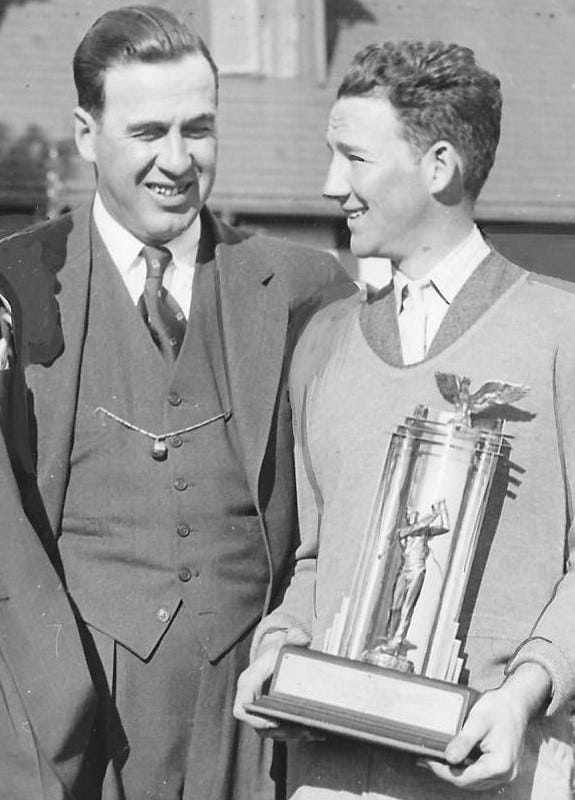
Northwestern Coach Ted Payseur and Sid Richardson holding the Big Ten individual trophy for winning in 1937 We mentioned in a previous post that Chick Evans has a lasting legacy through his scholarship fund which as of 2023 has provided financial support to thousands of caddies pursuing studies at one of nearly two dozen major universities. One of those early Evans Scholars was none other than Sid Richardson, an investment which would “pay back almost immediately” with Richardson winning back-to-back Big Ten individual titles in 1937 and 1938, as well as Northwestern winning team titles in 1937 and 1939. So, incredibly, one of the first awards that Evans would present as the NCAA Golf Chairman was to a player attending school (at least partially) on his scholarship.
Individual Champ: Vincent D’Antoni [Tulane]
On his way to the Finals, Tulane senior Vincent D’Antoni first had to pass through a gauntlet that included future Stanford coach (1948-1976) Charles “Bud” Finger and Iowa State great Billy Hall. D’Antoni was 1 down to Hall in their Semifinal match before racking up 3 birdies in the final 4 holes to win by a slim 1up margin. That victory earned him the chance to square up with another future Stanford hall of famer, Warren Berl, who also blazed an impressive path through the likes of Bert McDowell [LSU, last year’s runner-up], Tom Hoak [Iowa State captain], and Rennie Merritt [Yale]. Described repeatedly as having a “killer” game, D’Antoni overwhelmed Berl from the start and cruised to a 10&8 victory.
Championship Award Count
EXTRA HOLES: Chick Evans Bowl (1940 - 198?)
Even though this post is about the 1939 championship, post limitations and the size/nature of the next post forced us to consider covering this topic now. The 1940 tournament hosted by the Ekwanok Club (Manchester, VT) was a huge success for the NCAA thanks in large part to the man responsible for bringing the tournament back to club (1912 tournament): Beech-Nut CEO, Bartlett Arkell. Mr. Arkell was known as quite the character and donated many items over his lifetime, one of those things being a new trophy for the individual winner of the NCAA Golf Championship. The Chick Evans Bowl was introduced at the 1940 championship in a lavish ceremony where University of Virginia’s F Dixon Brooke was presented the large silver trophy to keep for the year along with a smaller replica for his personal trophy case.
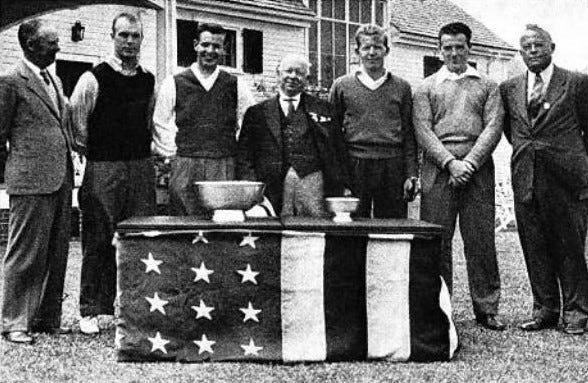
For the next 40+ years, the individual winner would take possession of the cup for a year and have their name engraved next to the other champions. So much history is captured on this trophy, which as of this writing is currently missing.
COACHES CORNER: Eddie Twiggs
Eddie Twiggs had already been well known in California golfing circles long before he was hired on as Stanford’s new golf coach in late 1931. His main duties were not as golf coach, however, but rather as golf pro at the Stanford Golf Club, where he ran the pro shop and gave lessons to many players of all ages. His first teams in 1932 and 1933 included Charles Seaver (father of Hall of Fame pitcher Tom Seaver), Harry “Bud” Eichelberger, and Lawson Little, who didn’t get a chance to contend for an IGA championship, but did win several team and individual “Pacific Coast Intercollegiate” (played at Pebble Beach!) titles. Twiggs took the first Stanford team to make an appearance at the IGA championships in 1936 where they finished 2nd. There were high hopes for the young 1937 team, but they finished middle of the pack in the championship.
The 1938 Stanford team was a true force, going through the regular season undefeated in their matches and both team and individual titles at the Pacific Coast Intercollegiate. At the IGA championship, the Indians (mascot at the time) shot a team score of 601 to win their first championship by 8 strokes over Northwestern and Oklahoma. This set the new low 4-man 36-hole stroke play record, down from Michigan’s 1935 total of 611.
As we covered above, the 1939 squad was able to repeat as champions, showcasing the dominance of the west coast team and solidifying the idea of the (now NCAA) championship as being truly national.

In a bit of a spoiler for the next post, here is some info on the other THREE championships that the Eddie Twiggs-lead Stanford teams were able to secure during what were essentially the WWII years:

(Photo from StanfordMensGolf.com) Three championships in four years means that Stanford has officially entered dynasty territory
This championship marks the first one conducted on a university’s course (Ohio State)
Stanford lowers their own 4-man 36-hole record down to 580
1942 (Notre Dame’s South Bend Country Club)
Don’t want to get into this one too much here as we will cover this championship in the next post
Just know that this championship puts Stanford in rarified air as one of only 3 teams (Yale and Princeton) to repeat more than once
1946 (Princeton’s Springdale Golf Club)

(Photo from StanfordMensGolf.com) The 1946 championship was the first held after the official end to WWII
“The foursome of Frank McCann, Bob Rosburg, Jack Shuler, and Bob Cardinal led Stanford to a 36-hole score of 619, five strokes better than Michigan”
The group apparently had to pay their own way to the championship that year, coming out of pocket $425 each (NOTE: this was not the first time a Stanford team had to do this)
Unable to travel with the team, Coach Twiggs had to wait to hear the news of his team’s triumph the same as everyone else
The following season (1947), Eddie Twiggs was elected as the first president of the newly created National Collegiate Golf Coaches Association for 1947-48. Shortly thereafter, it was announced the next tournament would be held at Stanford in 1948, which turned out to be Twiggs’s last before retiring. Stanford announced later that year that Bud Finger - member of 1939 and 1941 championship teams - would take over the position at the beginning of 1949, a position he would hold through the 1976 season. Coach Eddie Twiggs was greatly respected in the college golf community and is still considered one of the hall of fame coaches among hall of fame coaches.
Thanks for reading!
Up Next:
In the next post we will cover the WWII years. This one will be a little different. We’re going to center on the 1942 championship, but really the main focus is the about the players who fought (and sometimes died) defending the country.






